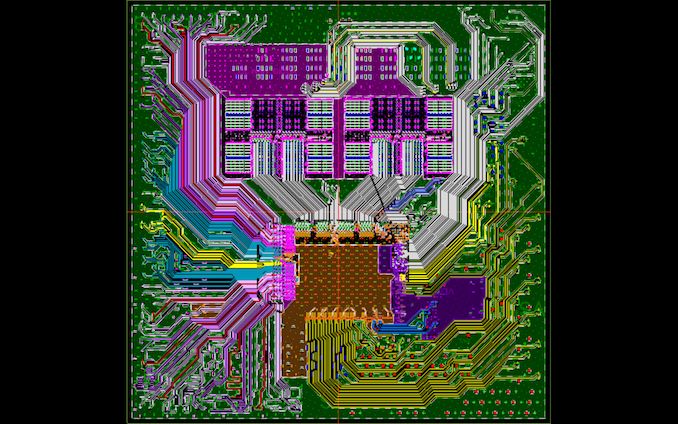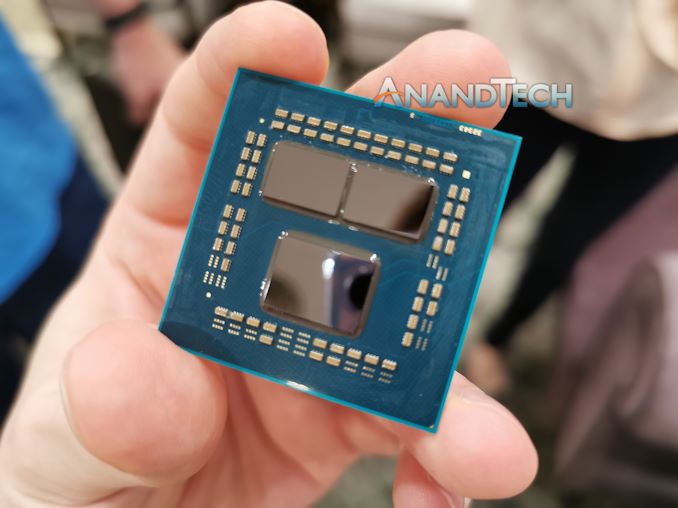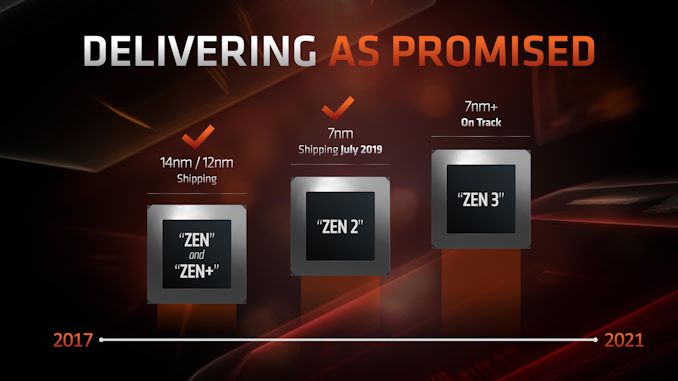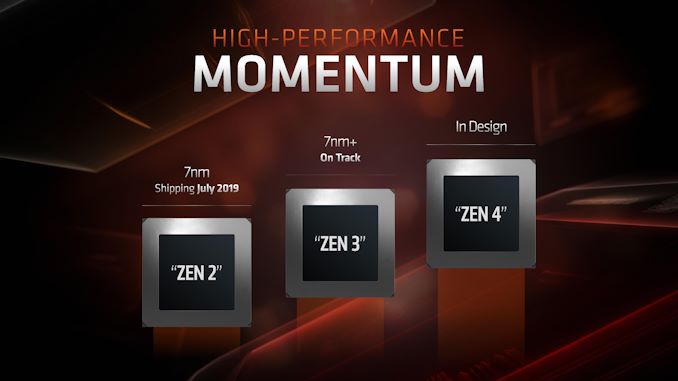AMD Zen 2 Microarchitecture Analysis: Ryzen 3000 and EPYC Rome
by Dr. Ian Cutress on June 10, 2019 7:22 PM EST- Posted in
- CPUs
- AMD
- Ryzen
- EPYC
- Infinity Fabric
- PCIe 4.0
- Zen 2
- Rome
- Ryzen 3000
- Ryzen 3rd Gen

Editor's Note: With Zen 2 set to launch tomorrow (7/7), here's our architecture analysis from last month for some timely background information.
We have been teased with AMD’s next generation processor products for over a year. The new chiplet design has been heralded as a significant breakthrough in driving performance and scalability, especially as it becomes increasingly difficult to create large silicon with high frequencies on smaller and smaller process nodes. AMD is expected to deploy its chiplet paradigm across its processor line, through Ryzen and EPYC, with those chiplets each having eight next-generation Zen 2 cores. Today AMD went into more detail about the Zen 2 core, providing justification for the +15% clock-for-clock performance increase over the previous generation that the company presented at Computex last week.
AMD’s Zen 2 Product Portfolio
The current products that AMD has announced that have Zen 2 cores include the Ryzen 3rd Generation consumer CPUs, known as the Ryzen 3000 family, and AMD’s next generation enterprise EPYC processor, known as Rome. As of today, AMD has announced explicit details of six consumer Ryzen 3000 processors, including core counts, frequencies, memory support, and power. Details about the server processor, aside from some peak values, are expected in due course over the next few months.
| AMD 'Matisse' Ryzen 3000 Series CPUs | |||||||||||
| AnandTech | Cores Threads |
Base Freq |
Boost Freq |
L2 Cache |
L3 Cache |
PCIe 4.0 |
DDR4 | TDP | Price (SEP) |
||
| Ryzen 9 | 3950X | 16C | 32T | 3.5 | 4.7 | 8 MB | 64 MB | 16+4+4 | 3200 | 105W | $749 |
| Ryzen 9 | 3900X | 12C | 24T | 3.8 | 4.6 | 6 MB | 64 MB | 16+4+4 | 3200 | 105W | $499 |
| Ryzen 7 | 3800X | 8C | 16T | 3.9 | 4.5 | 4 MB | 32 MB | 16+4+4 | 3200 | 105W | $399 |
| Ryzen 7 | 3700X | 8C | 16T | 3.6 | 4.4 | 4 MB | 32 MB | 16+4+4 | 3200 | 65W | $329 |
| Ryzen 5 | 3600X | 6C | 12T | 3.8 | 4.4 | 3 MB | 32 MB | 16+4+4 | 3200 | 95W | $249 |
| Ryzen 5 | 3600 | 6C | 12T | 3.6 | 4.2 | 3 MB | 32 MB | 16+4+4 | 3200 | 65W | $199 |
The Zen 2 design paradigm, compared to the first generation of Zen, has changed significantly. The new platform and core implementation is designed around small 8-core chiplets built on TSMC’s 7nm manufacturing process, and measure around 74-80 square millimeters. On these chiplets are two groups of four-cores arranged in a ‘core complex’, or CCX, which contains those four cores and a set of L3 cache – the L3 cache is doubled for Zen 2 over Zen 1.
Each full CPU, regardless of how many chiplets it has, is paired with a central IO die through Infinity Fabric links. The IO die acts as the central hub for all off-chip communications, as it houses all the PCIe lanes for the processor, as well as memory channels, and Infinity Fabric links to other chiplets or other CPUs. The IO die for the EPYC Rome processors is built on Global Foundries' 14nm process, however the consumer processor IO dies (which are smaller and contain fewer features) are built on the Global Foundries 12nm process.
The consumer processors, known as ‘Matisse’ or Ryzen 3rd Gen or Ryzen 3000-series, will be offered with up to two chiplets for sixteen cores. AMD is launching six versions of Matisse on July 7th, from six cores to sixteen cores. The six and eight-core processors have one chiplet, while above this the parts will have two chiplets, but in all cases the IO die is the same. This means that every Zen 2 based Ryzen 3000 processor will have access to 24 PCIe 4.0 lanes and dual channel memory. Based on the announcements today, the prices will range from $199 for the Ryzen 5 3600, up to $700+ for the sixteen core (we’re waiting on final confirmation of this price).
The EPYC Rome processors, built on these Zen 2 chiplets, will have up to eight of them, enabling a platform that can support up to 64 cores. As with the consumer processors, no chiplet can communicate directly with each other – each chiplet will only connect directly to the central IO die. That IO die houses links for eight memory channels, and up to 128 lanes of PCIe 4.0 connectivity.
AMD’s Roadmap
Before diving into the new product line, it is worth recapping where we currently sit in AMD’s planned roadmap.
In previous roadmaps, showcasing AMD’s movement from Zen to Zen 2 and Zen 3, the company has explained that this multi-year structure will showcase Zen in 2017, Zen 2 in 2019, and Zen 3 by 2021. The cadence isn’t exactly a year, as it has depended on AMD’s design and manufacturing abilities, as well as agreements with its partners in the foundries and the current market forces.
AMD has stated that its plan for Zen 2 was to always launch on 7nm, which ended up being TSMC’s 7nm (Global Foundries wasn’t going to be ready in time for 7nm, and ultimately pulled the plug). The next generation Zen 3 is expected to align with an updated 7nm process, and at this point AMD has not made any comment about a potential ‘Zen 2+’ design in the works, although at this point we do not expect to see one.
Beyond Zen 3, AMD has already stated that Zen 4 and Zen 5 are currently in various levels of their respective design stages, although the company has not committed to particular time frames or process node technologies. AMD has stated in the past that the paradigms of these platforms and processor designs are being set 3-5 years in advance, and the company states it has to make big bets every generation to ensure it can remain competitive.
For a small insight into Zen 4, in an interview with Forrest Norrod, SVP of AMD’s Enterprise, Embedded, and Semi-Custom group, at Computex, he exclusively revealed to AnandTech the code name of AMD’s Zen 4 EPYC processor: Genoa.
| AMD EPYC CPU Codenames | |||
| Gen | Year | Name | Cores |
| 1st | 2017 | Naples | 32 x Zen 1 |
| 2nd | 2019 | Rome | 64 x Zen 2 |
| 3rd | 2020 | Milan | ? x Zen 3 |
| 4th | ? | Genoa | ? x Zen 4 |
| 5th | ? | ? | ? x Zen 5 |
Forrest explained that the Zen 5 code name follows a similar pattern, but would not comment on the time frame for the Zen 4 product. Given that the Zen 3 design is expected mid-2020, that would put a Zen 4 product for late 2021/early 2022, if AMD follows its cadence. How this will play into AMD’s consumer roadmap plans is unclear at this point, and will depend on how AMD approaches its chiplet paradigm and any future adjustments to its packaging technology in order to enable further performance improvements.














216 Comments
View All Comments
GreenReaper - Wednesday, June 12, 2019 - link
The last you heard? It says clearly on page 6 that there is "single-op" AVX 256, and on page 9 explicitly that the width has been increased to 256 bits:https://www.anandtech.com/show/14525/amd-zen-2-mic...
https://www.anandtech.com/show/14525/amd-zen-2-mic...
To be honest, I don't mind how it's implemented as long as the real-world performance is there at a reasonable price and power budget. It'll be interesting to see the difference in benchmarks.
arashi - Wednesday, June 12, 2019 - link
Don't expect too much cognitive abilities regarding AMD from HStewart, his pay from big blue depends on his misinformation disguised as misunderstanding.Qasar - Thursday, June 13, 2019 - link
HA ! so that explains it..... the more misinformation and misunderstanding he spreads.. the more he gets paid.......HStewart - Thursday, June 13, 2019 - link
I don't get paid for any of this - I just not extremely heavily AMD bias like a lot of people here. It just really interesting to me when Intel release information about new Ice Lake processor with 2 load / s store processor that with in a a couple days here bla bla about Zen+++. Just because 7nm does not mean they change much.Maybe AMD did change it 256 width - and not dual 128, they should be AVX 2 has been that way for a long time and Ice Lake is now 512. Maybe by time of Zen 4 or Zen+++++ it will be AVX 512 support.
Korguz - Thursday, June 13, 2019 - link
no.. but it is known.. you are heavily intel bias..whats zen +++++++++ ????
x 86-512 ??????
but you are usually the one spreading misinformation about amd...
" and support for single-operation AVX-256 (or AVX2). AMD has stated that there is no frequency penalty for AVX2 " " AMD has increased the execution unit width from 128-bit to 256-bit, allowing for single-cycle AVX2 calculations, rather than cracking the calculation into two instructions and two cycles. This is enhanced by giving 256-bit loads and stores, so the FMA units can be continuously fed. "
HStewart - Thursday, June 13, 2019 - link
Zen+++++ was my joke as every AMD fan jokes about Intel 10+++ Just get over itx-86 512 - is likely not going to happen, it just to make sure people are not confusing vector processing bits with cpu bits 64 bit is what most os uses now. for last decade or so
Intel has been using 256 AVX 2 since day one, the earlier version of AMD chips on only had two combine 128 bit - did they fix this with Zen 2 - this is of course different that AVX 512. which standard in in all Ice Lake and higher cpus and older Xeon's.
Qasar - Thursday, June 13, 2019 - link
sorry HStewart... but even sone intel fans are making fun of the 14++++++ and it would be funny.. if you were making fun of the process node.. not the architeCture..."
x-86 512 - is likely not going to happen, it just to make sure people are not confusing vector processing bits with cpu bits 64 bit is what most os uses now. for last decade or so " that makes NO sense...
HStewart - Thursday, June 13, 2019 - link
One more thing I stay away from AMD unless there are one that bias against Intel like spreading misinformation that AVX 512 is misleading. and it really not 512 surely they do not have proof of that.AVX 512 is not the same as x86-512, I seriously doubt we will ever need that that but then at time people didn't think we need x86-64 - I remember original day of 8088,. no body thought we needed more 64meg AVX-512 is for vectors which is totally different.
just4U - Thursday, June 13, 2019 - link
I always have a higher end Intel setup and normally a AMD setup as well.. plus I build a fair amount of setups on both. No bias here except maybe.. wanting AMD to be competitive. The news that dropped over the past month was the biggest for AMD in over a decade HS.. If you can't even acknowledge that (even grudgingly..) then geez.. I dunno.This has been awesome news for the industry and will put intel on their toes to do better. Be happy about it.
Xyler94 - Monday, June 17, 2019 - link
HStewart, please. You don't stay away from AMD at all. You take ANY opportunity to try and make Intel look better than AMD.There was an article, it was Windows on ARM. You somehow managed to make a post about Intel winning over AMD. Don't spew that BS. People don't hate Intel as much as you make them out to be, they don't like you glorifying Intel.